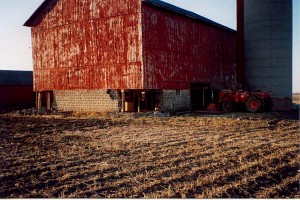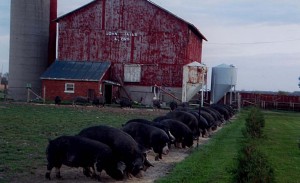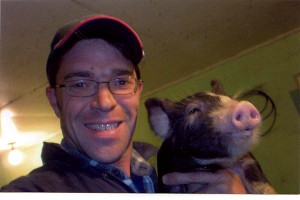I asked Gerhard what he liked about pigs.

“I didn’t actually like pigs all that much,” he said, “But what I did like about them is their young. Pigs have massive litters, up to ten piglets and more, and their fur feels like velvet; also they smell good. Usually I have straw and maybe wood shavings in their pen, where they are born, and they come out smelling a little bit like wood. They smell good when they’re dry. I didn’t get into pigs because I loved it. In fact I once told my dad that I’d never get into pigs. I’d smell like pigs. I had a room mate at agricultural college once who lent me his bedding and it smelled like a pig farmer. I used to grow a beard but it smelled so bad that I cut it off. It just had to be shaved. But before I cut it off though, on occasion I used it as a weapon. When a supplier had not been honest with me I got back at him by visiting him with my beard and generally smelling bad.”
I asked Gerhard what he did before he had pigs:
“At first I had a number of jobs: I was a shipping clerk at a greenhouse in Kingsville, installed windows and doors at T-Murr, I was a parts clerk at a John Deere dealership. All the time I was thinking about farming. I wanted to do some ‘low volume niche farming’. I wanted to produce a ‘value added product’, as they call niche farming, quality, not quantity, like you might say 5 acres of early tomatoes. I was still in construction when I was thinking about all these things. I wasn’t making enough money.”
One day Gerhard got the idea of touring 4 or 5 goat farms where he discovered that these animals were clean and easy to handle. In 2001 Gerhard started to build a barn for goats. He got the 700 cinder blocks free from the town arena and rebuilt a barn. The problem was that goats milk is stored on the farm and Gerhard’s farm was too far away for the milk to be picked up by the processors, who are in the Kitchener and Stratford area.

“In 2002 I got a call from the Co-Op, ” said Gerhard. “They told me they wouldn’t come around to pick up the milk. No goats. I couldn’t look at the barn for four years.”
Then Gerhard looked around for something else he might do. He told me:
“I saw another opportunity, which was to grow garlic, to get into garlic production. At that time word was out that the tarrif on Garlic was about to be lifted, which would make the growing of Garlic unprofitable.
“Soon I found that the market for Garlic was flooded. In the mean time all the work would have to be done after hours and I lacked the time, and money, to develop this industry. So that didn’t work out either.”
Then Gerhard attended an organic growers conference in Quelph which featured workshops on dual purpose livestock. In particular a method was shown of controlling thistles with pigs- a dual animal- because pigs love thistles.
“That’s how I caught the pig bug.”
Gerhard said that initially he had looked at the ‘ large blacks’. These are solid, long, big, pigs.
“They are lean and grow slowly,” said Gerhard. “At one time they were used for their fat, to grease wagon wheels with, but the advent of petroleum products made this practice obsolete. While they are now being raised for lean pork chops, the loss of fat in them has diminished their flavour. Restaurants want chickens and beef. Now they want premium pork.”
Gerhard was advised to grow Berkshires which produce meat that has the fat distributed in them so as to create marbled meat.
“I came up with Berkshire (England) – black body, white face and feet – researched for desirable meat and ability to withstand outside conditions,” Gerhard told me. “The Ontario Marketing Agency helped me get going.”
By this time Gerhard’s financial situation had improved because of his construction business and so he purchased 35 sows.

“They eat a mash of corn and soya beans I had my own water supply and a large empty barn –which is where the pigs were on Mar. 2006 – hungry, whenever I went in to feed them they mauled me, chewing off pant legs. The large round feeding cylinders I had were wrong for sows because the larger animals dominated the feeding facility. What was needed was a ‘limited feeding facility’ where the food was spread out – like outside feeding. Inside the barn this approach caused the food to be mixed up with manure – it was a mess. Also a problem was the fact that pigs fight, so I painted a bit of diesel oil on their backs and shoulders which pigs don’t like to get in their mouth.”
Pigs need a lot of straw to keep them clean. Modern pig farmers have a manure pit in their barns, like a two tier structure. The manure falls into the pit below. The floor is made of slats so that the manure falls through. Gerhard’s his barn uses straw and to collect the manure and he puts it onto the land with a manure spreader. Gerhard said:
“Meanwhile I used the shovel, pitch fork, and wheel barrow to get the manure from the barn on to the manure spreader and out on the field. All this was done in my spare time. The money making work was done in construction – during the daytime hours. This is where the money was made.”
Gerhard told me of several problems he had to solve:
“In an open pen the sow may not nurse, she may lie down and crush the piglets, the piglets may be too cold outside. So he had to modernize the ‘heritage facility’ by closing it up – meaning more confinement, sows were free to nurse. The next step, which is presently being done, is to build sow stalls for their gestation; one boar is always held in confinement. He is the primary breeder who sometimes needs assistance at his job. But he is better looking all around, and has a higher sperm count. The other boar is loose to wander with the sows – he’s the ‘clean up boar’. Breeding requires that one knows when the sows are in heat. Sows will ride one another, or growl.”
Gerhard says that he can now schedule his work because he owns his own business. Some of the things that have to be done include: breeding, feeding, cleaning out the manure, taking care of litters, vaccination, and keeping records.
He says:
“One never stops learning, there’s always something new. It took three years to learn. I was sliding down the hill for three years, now I’m on my way up. I now belong to the Blackbowfarms.com organization. This is a ‘high end pig organization’”.
Gerhard says he doesn’t know what exactly he loves about pigs but he loves them now. Pigs cannot easily be corralled. He uses a board rather than his legs to corral them because legs just don’t work. He has been knocked over by a recalcitrant pig many times. If it can be wiggled a pig will eventually destroy it, he says.

“A pig is like a solid football. ‘Feeder pigs’ weigh 280 pounds. You don’t talk to pigs like you do to dogs. Pigs don’t listen. When Jammie visits the pig establishment, as she sometimes does, she advises her little Liam: “Don’t listen. This is daddy’s pig talk.”
Gerhard says this is what pigs think:
“We are smarter than dogs, friendlier than cats, but we taste better.”
“By the way,” Gerrard says, “None of this would have come about without Jamie’s help. I had great support form her for all of my ventures.”
(back)
